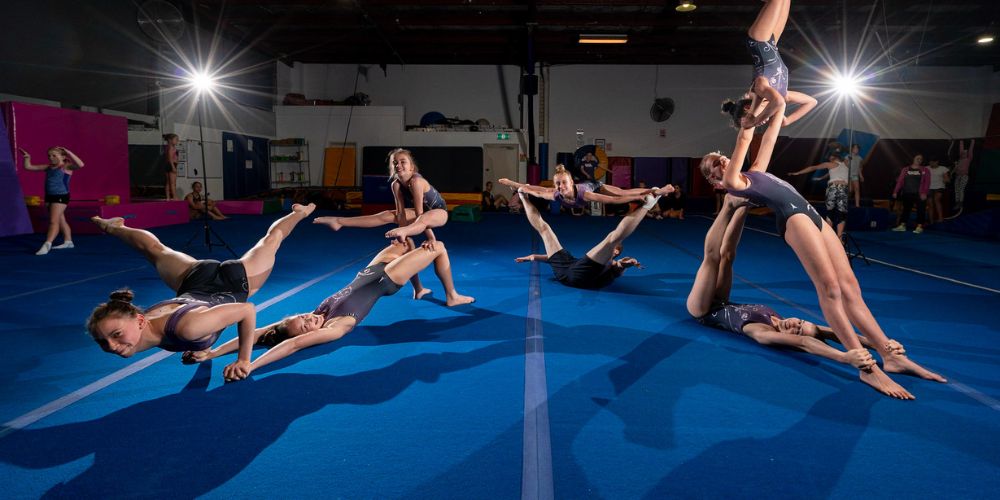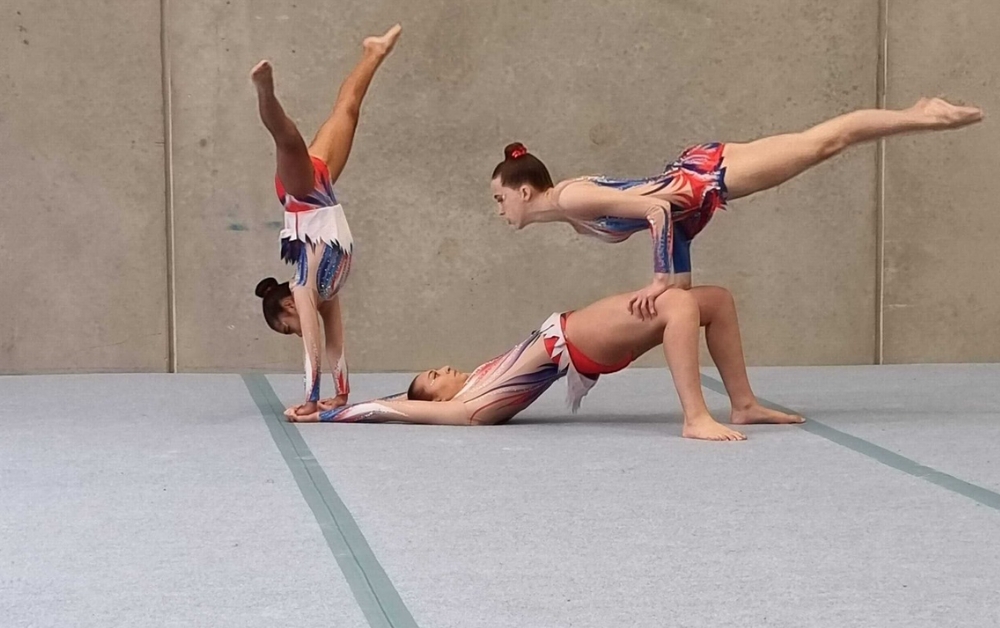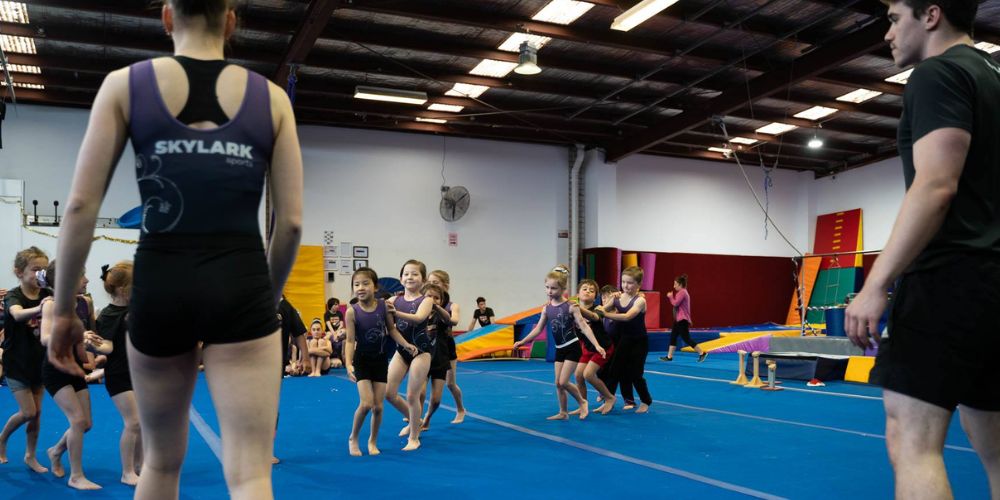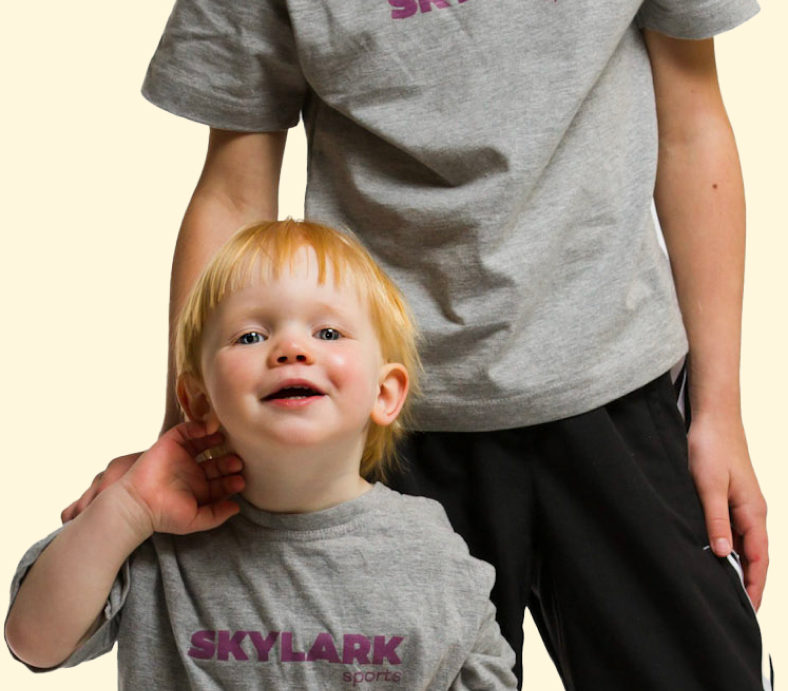From an audience point of view, gymnastic floors look like a springy stage where all the magic happens, right? But let me tell you, there's more to that floor than meets the eye!
You've seen us doing cartwheels, backflips, and sticking those landings like pros. But have you ever wondered what makes our gymnastic floor so special? What makes this simple space the perfect playground for our flips and tumbles?
The gymnastics floor, spring or tumbling floor, is a specialized surface used in gymnastics competitions and training. It provides a safe and supportive base for gymnasts to perform their routines, ensuring comfort and safety during high-impact landings and tumbling passes.

Why The Gymnastic Floor Matters?
Amidst the glamour and breathtaking gymnastics moves and tumbles our gymnasts make, their safety is always a top priority. As instructors, we understand that every flip and landing involves a calculated risk, and that's where the gymnastic floor steps in as a silent guardian.
Shock Absorption for Safety
Imagine not having a responsive, soft bottom while landing after a spectacular mid-air flip. Ouch! That's why the shock-absorbing capabilities of the gymnastic floor are so important. Specialised foam and technology work together like a cushion to protect our gymnasts' joints by absorbing impact. It functions similarly to a safety net, guaranteeing each landing is as thrilling as safe.
Precision in Landing
It's the landings that make up a flawless routine, not just the flips. The gymnastic floor ensures that each landing is controlled and exact. Our gymnasts can confidently land those landings because of its special materials, which offer the ideal grip. This accuracy reduces the possibility of slips and falls and serves a safety purpose.
Injury Prevention and Resilience
It is possible to worry about injuries in the erratic world of gymnastics. The robust nature of the gymnasium floor serves as a safety barrier. Together, the springs and foam provide a sensitive surface that lessens the force applied to the bodies of our gymnasts. It's similar to having a dependable partner who supports them when they recover from difficult maneuvers and ensures they can continue pushing the boundaries without endangering their safety.
Boost Your Confidence
Our gymnasts feel more confident knowing they have a sturdy and secure surface underneath them. They can concentrate on their routines without worrying about the surface they are performing on. Not only does this confidence provide them with a psychological lift, but it also makes their performance safer overall.
Enabling Progress and Innovation
The gymnasium floor is a driving force behind advancement, creativity, and safety. It gives our gymnasts a stage to experiment with new movements, challenge their limits, and develop their routines. They are encouraged to try new things on a safe and encouraging floor, which helps gymnastics as a sport continue to develop.

What Goes into Gymnastic Floors
Have you ever marveled at the seamless flips and tumbles on the gymnastic floor? It's not just the athletes' skill; the carefully crafted combination of materials makes those feats possible. Let's take a peek behind the scenes and uncover what goes into gymnastic floors:
Foam
At the core of every gymnastic floor lies foam. Specially designed foam layers provide the necessary cushioning and shock absorption. This ensures a soft landing for our gymnasts, minimizing the impact on their joints and allowing for a safer and more comfortable performance.
Springs
Have you ever wondered how gymnasts pull off those amazing rebounds? The secret sauce is the springs that are buried beneath the surface. These springs add to the floor's elasticity, making it responsive and allowing gymnasts to land gracefully. It excites each routine, like having a trampoline underneath the mat.
Carpet or Vinyl Covering
A gymnasium floor's top layer is frequently covered in vinyl or carpet. This covering has two functions: it gives the athletes traction to make exact motions and gives the floor a decorative touch. The choice of covering affects the usefulness and appearance of the floor and is influenced by elements such as grip, durability, and overall feel.
Wood Subfloor
Beneath the foam and springs, a wood subfloor usually acts as the structural foundation. This sturdy layer provides stability and support to the entire gymnastic floor system. The quality and type of wood used can impact the overall performance and longevity of the floor.
Velcro Strips
Have you ever wondered how the mats hold their place during those routines that defy gravity? The mats are frequently fastened to the floor with velcro strips to ensure they remain in place and don't move during energetic performances. A minor element makes a big difference in keeping our gymnasts' surfaces safe and steady.
Metal Frame
A metal frame is often incorporated into the design to give the floor its shape and structure. This frame provides rigidity and defines the boundaries of the floor. It's like the invisible scaffold that supports the entire performance area, ensuring a defined and secure space for gymnasts to showcase their skills.

How Do you Know if the Gymnastics Floor is Safe to Use?
Accidents happen when you least expect them. That's why, in our facility, we never take things for granted regarding our gymnasts' safety. Here's how we ensure that our gymnastics floor is always safe to use:
Routine Inspections
Visual checks regularly are a must. At our facility, we meticulously examine the entire gymnastics floor, looking for any signs of wear, tears, or damage. We ensure every inch of the mat is in excellent shape, leaving no space unturned.
Checks for Firmness and Consistency
We believe in the Goldilocks principle: the floor should be just right. Now and again, our coaches go across the floor to make sure the stiffness remains constant. Anyplace that feels unusually soft or hard indicates that there may be a problem with the foam or springs, which needs to be looked at and fixed.
Bounce Test for Shock Absorption
In gymnastics, a little bounce goes a long way, but it needs to be precisely right. To determine how efficiently the floor absorbs shock, we conduct a bounce test in which we leap from a moderate height. It should offer a soft landing devoid of undue bounce or startling collision. We investigate if something seems wrong.
Evaluation of Grip and Traction
Athletes should feel in control, not slipping and sliding. Our instructors often stroll and execute deliberate moves to gauge the grip and traction of the floor. Whether the flooring is vinyl or carpet, we ensure enough friction stops people from slipping and falling.
Examine Mat Fastening Mechanism
If several mats on the gymnasium floor are fastened together with Velcro strips, examine the fastening system. The mats should be firmly fixed, and the Velcro strips should be in good shape. Unsecured matting can cause trip hazards and disturb the level of the flooring.
Assess Frame Integrity
Examine the metal frame that delineates the gymnasium floor's perimeter. Ensure there is no obvious damage or instability and it is firmly in place. A sturdy frame reduces potential risks around the edges and adds to the floor's overall stability.
Professional Oversight
Sometimes, you need an expert eye. That's why we bring in professionals for a thorough inspection. Their trained expertise helps identify subtle issues that might go unnoticed during routine checks. We value the added layer of assurance they provide.
Ask for the Athlete's Feedback
Our athletes are our partners in safety. We encourage them to communicate discomfort, unusual sensations, or concerns during practice or performances. Their feedback is invaluable in catching potential safety issues early on.
Frequently Asked Questions
How do you prevent mat-related safety issues?
The fastening mechanism of our mats is regularly inspected to ensure they are securely attached with Velcro strips. Loose mats are not only a tripping hazard but can also disrupt the evenness of the floor surface.
Are there specific signs during inspections that indicate potential safety issues?
Signs such as uneven areas, tears in the covering, or visible damage to the subfloor are red flags during inspections. These indicators prompt us to investigate further and promptly address potential safety issues.
How do you address issues related to the floor's structural foundation?
Regular inspections include assessing the wood subfloor's stability and the gymnastic floor's structural foundation. Any issues identified are addressed promptly to ensure the overall stability and safety of the floor.
Conclusion
So, if you think the gymnastics floor is just a surface for flips and tricks, think again. It's not just a stage; it's the heartbeat of our gymnastic world, ensuring every routine is a safe and spectacular performance.
From routine inspections to bounce tests, we leave no stone unturned to guarantee that our gymnastic floor is more than a floor—it's a reliable partner in every landing, every jump, and every routine.
So, the next time you watch a gymnastics performance, remember that beneath every twist and turn lies the assurance of a floor meticulously designed for safety and success. It's not just a floor; it's the foundation for every soaring moment in gymnastics.

